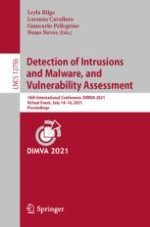This book constitutes the proceedings of the 18th International Conference on Detection of Intrusions and Malware, and Vulnerability Assessment, DIMVA 2021, held virtually in July 2021.
The 18 full papers and 1 short paper presented in this volume were carefully reviewed and selected from 65 submissions. DIMVA serves as a premier forum for advancing the state of the art in intrusion detection, malware detection, and vulnerability assessment. Each year, DIMVA brings together international experts from academia, industry, and government to present and discuss novel research in these areas.
Chapter “SPECULARIZER: Detecting Speculative Execution Attacks via Performance Tracing” is available open access under a Creative Commons Attribution 4.0 International License via link.springer.com.
